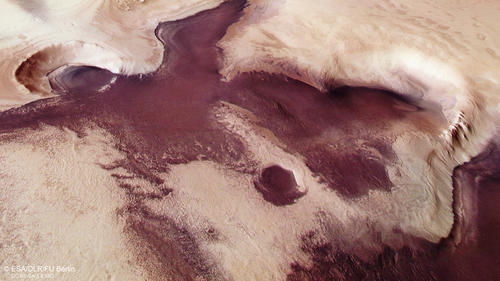Dark Angel - Big Heart - Mars is ready for Christmas
Lots of "ice" and snow
The dark angel and the heart, both consisting of volcanic sands, are located in the southern polar region of the planet, not far from the polar cap, at approximately 78 degrees south. Currently it is summer at this location. The permanent ice cap, consisting mostly of water ice and frozen carbon dioxide, now has a diameter of 400 kilometres and an average thickness of 1.5 kilometres. These are dimensions that are roughly comparable to the ice-covered island of Greenland on Earth. However, it is only this size in the southern summer. During the six-month winter, the south pole ice cap on Mars extends further, to almost 60 degrees south. Even in summer in the southern hemisphere of Mars, temperatures never rise above zero degrees Celsius. In winter, temperatures down to minus 133 degrees Celsius cause the carbon dioxide from the atmosphere to freeze and fall onto the ice cap as snow. This blanket of carbon dioxide ice is between one and two metres thick and sublimates again with the next spring, thus evaporating and re-exposing the landscape. Only on the permanent ice cap of the south pole does a thin layer remain. The atmosphere on Mars contains very little water vapour that can freeze to form ice. Water vapour forms only 0.02 percent of the planet's gas envelope, which consists mainly of carbon dioxide and nitrogen; on Earth, there is twenty times more water vapour in the atmosphere, averaging a concentration of 0.4 percent. Therefore, the angel and the heart are only visible in the southern summer; in winter they lie hidden under the layer of frozen carbon dioxide.
The angel figure as a dune field
In the upper centre of the images, an impact crater approximately 15 kilometres across can be seen, in which dark sands form the 'angel's head’. With a little imagination, the almost one-thousand-metre-high crater rim can even be interpreted as a halo. In several places, the layered deposits of the polar cap, consisting of ice mixed with dust, are clearly visible on the upper slopes. Even in the oval depression that forms the 'angel's hand', the view of the layered polar deposits is unobstructed.
The southern part of the images is also covered by stratified deposits. These consist of ice and dust as well, but they are much more finely layered, thinner and cover the south polar deposits. This type of deposit covers large parts of the high latitudes of Mars (approximately between 40 and 80 degrees north and south respectively), which is why it is referred to as a 'latitude-dependent mantle'. In many places, degradation phenomena due to erosion and sublimation of the ice in spring and summer are visible in the mantle, which has created several small geological windows in which the finer layer structure can also be seen on close inspection.
In the centre of the images, beneath the angel's outstretched wing, is a large, heart-shaped depression bounded by a scarp leading to another large dark dune field. The dark material, consisting of olivine and pyroxene minerals, may have come from deeper layers of deposited volcanic eruptive material or could have been blown into the depression. In the latter case, the edges of the terrain would have acted as windbreaks, causing the sands to slow down and be deposited there. This dark material is distributed globally on Mars and forms imposing dune fields in countless impact craters.
…and Dust-Devils
On a very light-toned and flat surface, a large number of dust devil tracks (See scheme: Emergence of dust devils) can be spotted on the left side of the image crisscrossing each other as dark streaks. Those marks are left behind when dust devils blow away the dust cover of the surface on their path.An oval hollow (hand of the angel) appears to be a large sublimation pit, maybe formed around a crater and allowing a view on the layered structure of polar deposits.
